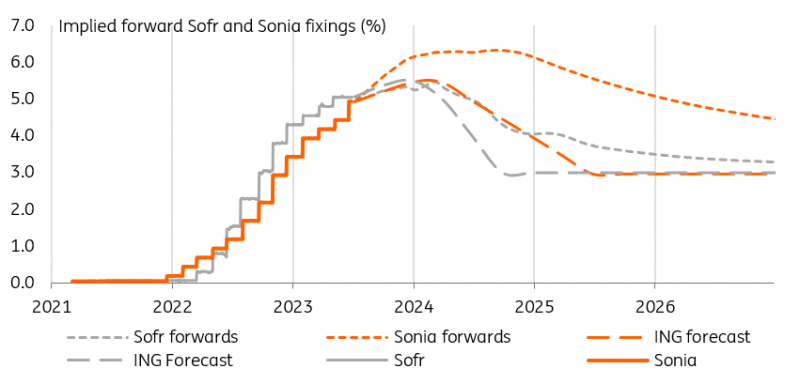
Central banks aren’t ready to see the glass half full
There are plenty of indications that inflation pressure in developed markets is easing… if you’re willing to believe in survey data and leading indicators. Germany’s Zew saw another decline in July although, as a survey of investors’ sentiment, we’re never quite sure if it leads economic data or the other way around. More telling perhaps were the details of the National Federation of Independent Businesses (NFIB) index showing a slowdown in selling prices and compensation. Even the UK labour indicators showed easing supply constraints, although private sector wages are likely to give the Bank of England (BoE) sleepless nights. All is heading in the right direction then if you’re willing the see the glass half full.
Past forecast mistakes and too slow a pace of disinflation mean central banks are likely to err on the side of remaining too hawkish for too long
But that’s not how central banks see it. Past forecast mistakes and too slow a pace of disinflation (we’re not even sure we can yet talk of disinflation in the UK) mean they are likely to err on the side of remaining too hawkish for too long. The Bank of Canada (BoC) meeting today should deliver the second since it restarted its hiking cycle last month. Rightly or wrongly, it is seen as a bellwether for other central bank decisions later this month, and in early August in the case of the BoE. The Fed’s decision is seen as more momentous for other central banks, given how a strong dollar could complicate their own fight against inflation. This makes today’s a very important data input into central banks’ July decisions.
The problem for rates markets is that, much like the leading/lagging indicators dichotomy, there are two ways to look at today’s report. With base effects and energy pulling the headline annual number back very close to 3% (if consensus is to be trusted), investors are likely to be showered with headlines of the ‘inflation is back to its lowest level since early 2021’ kind. The reality is more nuanced. A 0.3% monthly rate on both the headline and core readings is consistent with 3.6% annual inflation. Progress, but celebration is premature when the source of inflation is now moving to much less mean-reverting components, and last month’s job report suggests wages are not letting up either.
If the BoE hikes by another 50bp in August, there is room for curve inversion

Source: Refinitiv, ING
Higher for longer vs panic hikes
There are two ways to deal with stubbornly high inflation and an economy that, so far at least, doesn’t seem that bothered by the amount of policy tightening delivered in this cycle. One is the Fed’s. In short, signalling that the peak is near but that rate cuts are still a long way away. This isn’t an easy message to deliver, but the Fed has had some success. The curve still prices 125bp of easing in 2024, and the Fed’s ‘dot plot’ signals . If the strategy is to signal ‘higher for longer’ rates, this may well be the next target for the Fed.
The US short-end curve may well re-steepen to reflect steady policy rates for a longer period of time, while the UK curve should invert further
Contrast that with the BoE’s . It’s an open question whether this hike will be repeated in August. Next week’s inflation print, especially the services component, is widely seen as the final piece of the jigsaw. A repeat would speak to a different strategy to the Fed’s, whereby rates are raised to however high is necessary in order not to lose credibility. With policy rates already at 5%, confidence that rates will eventually drag on the economy is growing. To us, this points to differing curve dynamics, where the US short-end curve may well re-steepen to reflect steady policy rates for a longer period of time, while the UK curve should invert further.
Today’s events and market view
Ahead of a busy Northern American calendar, this morning’s list of European events is rather thin. Spain’s CPI reading will be a final release, and BoE Governor Andrew Bailey’s speech should be focused on financial stability, and so less likely to comment on recent data.
Bond supply today will come from the UK, US, and Germany selling 10Y debt, and Portugal selling bonds with 2029 and 2035 maturity.
The main dish on today’s economic menu will be the US CPI report where the core and headline readings are still expected to grow at a 0.3% monthly pace, which annualises to 3.6%. The annual headline figure converging to 3% for the first time since March 2021 may be what headlines focus on, however.
The Bank of Canada’s (BoC) decision to restart its hiking cycle in June after a five-month hiatus is largely expected to be followed by another 25bp hike. Any indicator on the pace of future hikes will likely be parsed by investors in other currencies, seeing the BoC as a bellwether for other developed market central banks.
First published on Think.ing.com.






